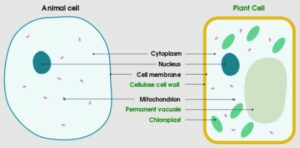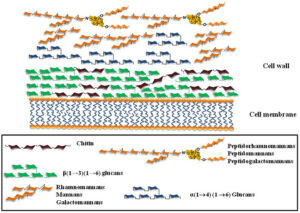Contents
- Why do animal cells not have a cell wall?
- What cells do not have a cell wall?
- Which cell has a cell wall?
- Are carbohydrates found in cell walls?
- Do animals use carbohydrates to build their cell membranes and cell walls?
- Do animal cells have a cell wall or cell membrane?
- Do animal cells have a cell wall or chloroplasts?
Why do animal cells not have a cell wall?
Animal cells do not require a cell wall. Since, cell wall maintains shape and act as exoskeleton. This provide rigidity to the plants and helps them to stand upright without bones.
Animals normally has eukaryotic cells in their body, surrounded by a cell membrane (also known as plasma membrane), cell organelles and nucleus enclosed inside the nuclear membrane. In contrast to the fungal and plant eukaryotic cells, animal cells don’t have a cell wall.
Furthermore, what might occur if animal cells bears a cell wall?
Animal cells might end up with hampered exocytosis and endocytosis as cell wall is impermeable to a variety of biomolecules. The cell wall protects a cell under adverse conditions and it protects the plant cell from collapse.
If animal cells had cell wall, their movement would have been hampered. We will explain this with an example; sponges and corals that do not move and lives in colony usually form structures like cell wall.
The phylogenetic journey of plants and animals is very different, each of them has different requirements. For animals, ability to move is a noteworthy advantage. Having cells without the inflexibility of cell wall implied more prominent motility and flexibility.

What cells do not have a cell wall?
The animal cells usually don’t have a cell wall in place of it they have the cell membrane. Cell wall is a fundamental component which assists us with recognizing plant and animal cells.
Among prokaryotes, Mycoplasma and L-form bacteria lacks cell wall. Mycoplasma is a is the causative organism in various diseases of animals and isn’t influenced by cell wall attacking antibiotics. Mycoplasma procures cholesterol from the extra cellular environment and produce sterols to synthesize their cytoplasmic membrane.
The peripheral layer of the animal cell is the cell membrane which is also known as the plasma layer.
Read more on Nucleoside
Which cell has a cell wall?
Cell wall is found in algae, plants, fungi and bacteria.
A cell divider is a genuinely tough layer encompassing a cell, it is situated outside of the cell membrane that offers extra protection and support. Some protists and animals lack cell wall and they are only surrounded by cell membrane.
Are carbohydrates found in cell walls?
Carbohydrates are found on the cell surface of a majority of organisms along with the cell wall components.
- Cellulose is a biopolymer made up of carbohydrate subunits (glucose) that is present in the plant cell wall.
- Chitin is a carbohydrate polymer found in the fungal cell wall.
- peptidoglycan (a carbohydrate polymer) and lipids that makes up the cell wall of many bacteria.
The cell wall of Archaebacteria doesn’t contain peptidoglycan. It has pseudopeptidoglycan in place of that. Proteins and some other polymers makes up peptidoglycan.
Some bacteria have an additional layer that protects them from foreign entities. This capsule of Polysaccharide assists the cells with connecting to diverse surfaces.

Do animals use carbohydrates to build their cell membranes and cell walls?
Carbohydrates are the third most abundant substances present in the plasma membranes of living organisms.
These carbohydrates are found on the surface of cell membrane. These membrane carbohydrates are usually found attached to lipids (to form glycolipids) and proteins (to form glycoproteins). These membrane carbohydrate oligomeric chains might comprise of 2–60 monosaccharide units and may acquire branched or linear structure.
Membrane carbohydrates forms specific regions that allows cellular recognition. Carbohydrates that are present on the outside surface of the cell are the carbohydrate parts of the glycolipids and glycoproteins that combinedly known as the glycocalyx (signifying “the sugar coat”).
This glycocalyx is extremely hydrophilic (attract towards water). This makes the cell more accessible to the watery micro-environment and in the cell’s capacity to get water dissolved substances.
As talked about over, the glycocalyx is additionally significant in recognition of cells as self/non-self components. Furthermore, glycocalyx is also utilized in cell-cell connections to give rise to tissues.
Do animal cells have a cell wall or cell membrane?
Animal cells do not possess a cell wall but they have a well defined cell membrane.
Animal cells are basically eukaryotic cells, encased by a plasma/cell membrane and containing a nucleus and cell organelles (both are covered by double membrane). Furthermore, the eukaryotic cells of fungi and plants possess cell wall, but animal cells don’t.
Do animal cells have a cell wall or chloroplasts?
Animal cells do not posses cell wall, nor they have chloroplasts.
Cell wall provides a regular shape to the cell. Hence, it is required by plants as plant parts are fragile and don’t have any exoskeleton and protection. As plants synthesize their own food, they need chloroplasts however as animal depend on different living beings for food, that’s why they don’t need chloroplasts.
Also Read:
- Do animal cells have cilia
- Do humans have animal cells
- Do animal cells have a central vacuole
- Do animal cells have cytoplasm
- Do animal cells have vacuoles
- Do animal cells have flagella

I am Abdullah Arsalan , Completed my PhD in Biotechnology. I have 7 years of research experience. I have published 6 papers so far in the journals of international repute with an average impact factor of 4.5 and few more are in consideration. I have presented research papers in various national and international conferences. My subject area of interest is biotechnology and biochemistry with special emphasis on Protein chemistry, enzymology, immunology, biophysical techniques and molecular biology.